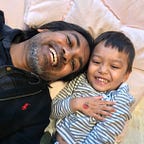Surveillance Capitalism’s Reflexive Impression on the Arts
As behavioral models that we as UXers put together become the most sought after commodities of the Information Age, surveillance capitalism is having its proscriptive impact on our lifestyles.
Generations ago, before the music industry gave favor to digital tools and “efficiencies” to maximize profit, artists were left to less proscriptive creative methods that didn’t involve pressing a button to release a sampled sound long departed from its organic source. Indeed, the severe limitations of such a model have reduced modern music at its worst to a looped digital track with a person childishly rhyming on top of it the way we were all taught how to do in second grade. Variations in dynamic range, key, orchestration and instrumentation, rhythm, emotional nuance etc., are a thing of the past while the most powerful voices of the music industry are little more than tone-deaf commodities brokers. In the meantime, our school systems have also become obsessed with the measurable while putting the arts on hold. For those brutally honest with ourselves, Hamlet’s esoteric question “to be or not to be” has been answered for the human race. “Not to be” is the order of the day.
So what do people do when they’re not being? Generation X particularly recalls the transitional time between analog and digital creativity. We know the promises, the perils, and the pitfalls of what happened next. Millennial behavior comes forward packaged neatly with a bow on top. Safe and predictable, we adhere to the belief that giving people what they want is a good; that the market dictates what is right or wrong for our culture.
By remaining on the dimensional plane of our neighbor, culture czars and so-called “influencers”, we leave out the remotest opportunity to be enlightened. Instead we tread thr pop culture cesspool, revolving around uninspired behavior and therein letting such behavior become our guides in building the future; a meta-context of human behavior after human behavior was influenced by systems that were markedly crude in their inputs, and therefore the outputs they would deliver. We now stand to freeze our culture in this decrepit state as a predictive model that in turn becomes a proscriptive model for future generations. So begins the process of form, impressed upon life, resulting in matter. The process of crime. Grim, to say the least.
We now stand to freeze our culture in this decrepit state as a predictive model that in turn becomes a proscriptive model for future generations.
As we toss around the word “freedom” to describe our lifestyle in democratic societies, we are aware that there are varying degrees of it. All we have to do is try and touch our left elbow with our left hand to realize that the effort to transgress form is a somewhat futile one. And of course, unenlightened with this realization, we live in an age where people try to do this in increasingly perverse manners. Superficial transhumanists satisfied with cheap parlor tricks contort and mutilate natural order in a puny terrestrial charade. We call it “shock value”, “the next big thing”, and we’re running out of it. We have long since hit 11 on the volume dial. Humans are relatively similar in their needs and wants; their inputs and outputs. Contorting ourselves in reactionary movements becomes an exercise in caricature. The only true evolution was known as the evolution of consciousness, and remains the only model of human behavior that has a positive outcome for the human race.
Ex nihilo nihil fit. A means to touch the divine finds its way into the cultures of every enlightened era in history. We witness its manifestation over the centuries in various ways through the arts and religion aiming to impart what the senses cannot. But external culture grows dense with the deconstruction of human consciousness into predictable models of a common denominator, and sadly, technology has made its impression on us more so than we on it. We as end user advocates vie for end user behavior to rule the design of our applications, and this suffices for most practical circumstances.
Yet the struggle remains with our greatest tools of art, music and literature to transmit something that we can only produce when at the pinnacle of our creativity as a species: divine inspiration, rather than a reflection of ourselves in decline. Until artists can again, with conviction, comsider themselves mere vessels of a higher intelligence, we are left in a downward spiral of degrading self-reference.
Question: The above quote implies risk and a departure from formula in a competitive product design context. And sometimes it can be inspirational, especially for those in the trade. But in the arts and music we find this same quality heightened and in its purest form; able to touch so many more in its universal nature. Is the specific degredation of this space, then, our greatest cultural issue? What effort must it take to humble and ultimately pivot the collective ego?
